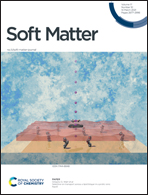Nanopore gates via reversible crosslinking of polymer brushes: a theoretical study
Abstract
Polymer-brush-modified nanopores are synthetic structures inspired by the gated transport exhibited by their biological counterparts. This work theoretically analyzes how the reversible crosslinking of a polymer network by soluble species can be used to control transport through nanochannels and pores. The study was performed with a molecular theory that allows inhomogeneities in the three spatial dimensions and explicitly takes into account the size, shape and conformations of all molecular species, considers the intermolecular interactions between the polymers and the soluble crosslinkers and includes the presence of a translocating particle inside the pore. It is shown than increasing the concentration of the soluble crosslinkers in bulk solution leads to a gradual increase of its number within the pore until a critical bulk concentration is reached. At the critical concentration, the number of crosslinkers inside the pore increases abruptly. For long chains, this sudden transition triggers the collapse of the polymer brush to the center of the nanopore. The resulting structure increases the free-energy barrier that a translocating particle has to surmount to go across the pore and modifies the route of translocation from the axis of the pore to its walls. On the other hand, for short polymer chains the crosslinkers trigger the collapse of the brush to the pore walls, which reduces the translocation barrier.



 Please wait while we load your content...
Please wait while we load your content...
